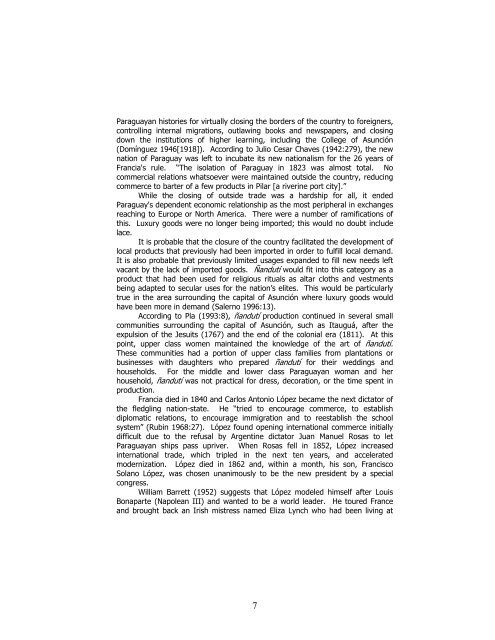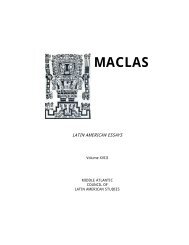latin american essays maclas
latin american essays maclas
latin american essays maclas
You also want an ePaper? Increase the reach of your titles
YUMPU automatically turns print PDFs into web optimized ePapers that Google loves.
Paraguayan histories for virtually closing the borders of the country to foreigners,<br />
controlling internal migrations, outlawing books and newspapers, and closing<br />
down the institutions of higher learning, including the College of Asunción<br />
(Domínguez 1946[1918]). According to Julio Cesar Chaves (1942:279), the new<br />
nation of Paraguay was left to incubate its new nationalism for the 26 years of<br />
Francia's rule. “The isolation of Paraguay in 1823 was almost total. No<br />
commercial relations whatsoever were maintained outside the country, reducing<br />
commerce to barter of a few products in Pilar [a riverine port city].”<br />
While the closing of outside trade was a hardship for all, it ended<br />
Paraguay's dependent economic relationship as the most peripheral in exchanges<br />
reaching to Europe or North America. There were a number of ramifications of<br />
this. Luxury goods were no longer being imported; this would no doubt include<br />
lace.<br />
It is probable that the closure of the country facilitated the development of<br />
local products that previously had been imported in order to fulfill local demand.<br />
It is also probable that previously limited usages expanded to fill new needs left<br />
vacant by the lack of imported goods. Ñandutí would fit into this category as a<br />
product that had been used for religious rituals as altar cloths and vestments<br />
being adapted to secular uses for the nation’s elites. This would be particularly<br />
true in the area surrounding the capital of Asunción where luxury goods would<br />
have been more in demand (Salerno 1996:13).<br />
According to Pla (1993:8), ñandutí production continued in several small<br />
communities surrounding the capital of Asunción, such as Itauguá, after the<br />
expulsion of the Jesuits (1767) and the end of the colonial era (1811). At this<br />
point, upper class women maintained the knowledge of the art of ñandutí.<br />
These communities had a portion of upper class families from plantations or<br />
businesses with daughters who prepared ñandutí for their weddings and<br />
households. For the middle and lower class Paraguayan woman and her<br />
household, ñandutí was not practical for dress, decoration, or the time spent in<br />
production.<br />
Francia died in 1840 and Carlos Antonio López became the next dictator of<br />
the fledgling nation-state. He “tried to encourage commerce, to establish<br />
diplomatic relations, to encourage immigration and to reestablish the school<br />
system” (Rubin 1968:27). López found opening international commerce initially<br />
difficult due to the refusal by Argentine dictator Juan Manuel Rosas to let<br />
Paraguayan ships pass upriver. When Rosas fell in 1852, López increased<br />
international trade, which tripled in the next ten years, and accelerated<br />
modernization. López died in 1862 and, within a month, his son, Francisco<br />
Solano López, was chosen unanimously to be the new president by a special<br />
congress.<br />
William Barrett (1952) suggests that López modeled himself after Louis<br />
Bonaparte (Napolean III) and wanted to be a world leader. He toured France<br />
and brought back an Irish mistress named Eliza Lynch who had been living at<br />
7




